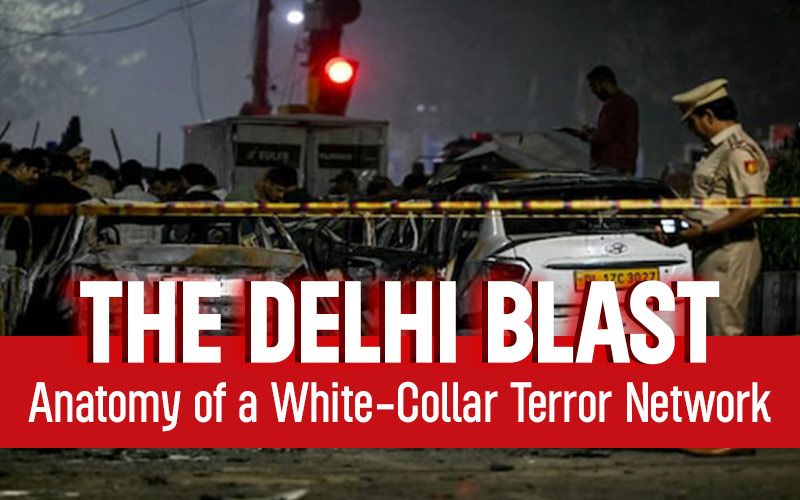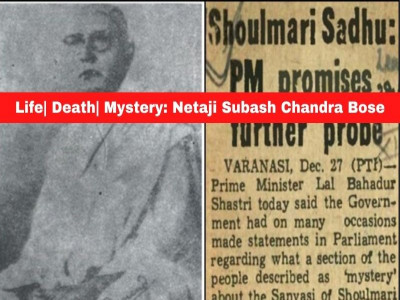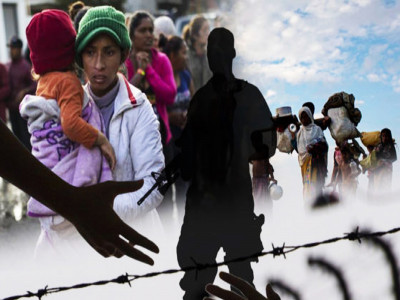
The Delhi Blast: Anatomy of a White-Collar Terror Network
On the evening of November 10, 2025, a white
Hyundai i20 parked near Delhi’s Red Fort erupted in flames, shattering the calm
of a historic neighborhood and claiming at least a dozen lives. What
initially appeared to be an isolated explosion quickly spiraled into one of the
most complex terror investigations in
recent years.
As evidence emerged, the narrative shifted from a
single act of violence to a chilling revelation - a terror network of educated professionals, where doctors, academics, and clerics operated
under the radar in the heart of India’s capital.
The Faridabad Trail: From
Hospital Wards to Bomb Factories
Barely 45 kilometres from Delhi, in Faridabad,
investigators uncovered nearly 2,900
kilograms of explosives hidden inside
rented apartments. These spaces were linked to individuals who, on paper,
looked nothing like conventional extremists, qualified doctors, and university employees.
One of them, Dr.
Muzammil Ganaie, a physician from
Pulwama employed at Al Falah University’s medical facility, allegedly used his
professional cover to coordinate the movement and concealment of explosive
materials. Another, Dr. Shaheen Sayeed from Lucknow, was found to be connected to the
same network.
The size of the cache and the sophistication of the
logistics pointed to something far bigger, possibly multiple coordinated attacks across the Delhi–NCR region. But when the Faridabad module was compromised,
the entire operation began to unravel.
The Trigger: Dr. Umar Mohammad Nabi’s Fatal Decision
Central to the Delhi explosion is the name Dr. Umar Mohammad Nabi, a medical practitioner from Pulwama who had
allegedly fallen under the influence of JeM-linked radical networks.
According to investigators, Dr. Umar was operating the
Hyundai i20 that exploded near the
Red Fort. When he learned that his
close associates in the Faridabad module - including Dr. Muzammil Ganaie - had
been arrested and their explosive stockpile seized, he panicked.
Believing that the network had been compromised and
that capture was imminent, Umar allegedly triggered
the explosive device inside his car,
causing the blast that shocked Delhi and exposed the existence of a “white-collar terror cell” unlike any seen before.
The incident was not a planned suicide mission in the
traditional sense, but a desperate
act of containment, a tragic, violent
attempt to destroy evidence and avoid arrest.
The ‘White-Collar Module’: When Professionals Turn Radical
The arrests in Faridabad and Delhi have unearthed what
investigators are calling a “white-collar
terror module” - an underground
network made up not of foot soldiers, but doctors,
clerics, and businessmen.
These individuals operated quietly, leveraging their
education and social respectability to conceal radical intent. The module
allegedly served as a new recruitment
and logistics wing for
Jaish-e-Mohammed (JeM), tasked with creating homegrown terror cells using
India’s own professional class.
Such individuals, fluent in English, working in
hospitals and universities, could move resources, spread ideology, and evade
suspicion far more effectively than traditional operatives. This strategy marks a calculated shift
in JeM’s operational doctrine,
designed to infiltrate spaces considered beyond the reach of radicalisation.
The Doctor and the Maulana: A Fusion of Intellect and Indoctrination
At the ideological core of this network stood a
cleric: Maulvi Irfan Ahmad, a Kashmiri imam who also worked as a paramedic.
He is believed to have played a central role in radicalising young doctors and students, blending religious rhetoric with narratives of professional “duty”
and moral obligation.
Through sessions disguised as spiritual discussions and community mentorship, Irfan allegedly cultivated a circle of educated recruits, convincing them that their scientific skills and social standing could serve a “higher cause.” Among his most notable recruits, Dr. Shaheen Sayeed was allegedly assigned by JeM to create a “women’s wing” of this white-collar network, a covert platform for recruiting educated women into extremist activities and logistical roles.
This convergence of religious indoctrination and academic respectability makes the module uniquely dangerous, a blend of intellect, ideology, and invisibility.
Jaish-e-Mohammed’s Invisible Hand
Investigators believe the module operated under direct or indirect supervision of Jaish-e-Mohammed, the Pakistan-based outfit responsible for
numerous attacks in India, including Pulwama (2019). JeM’s involvement in the Delhi blast underscores a new
strategy: embedding ideology within
education, transforming doctors and
scholars into ideologically motivated insiders capable of conducting operations
without external aid.
Dr. Umar Mohammad Nabi’s decision to detonate the car
bomb near Red Fort is seen as both a tactical failure and a symbolic act, a
sign that Jaish’s white-collar cell
was collapsing under pressure after
the Faridabad bust.
The Red Fort Message: Symbolism and Strategy
The Red Fort was no random target. As the site of the
Prime Minister’s Independence Day address and a symbol of India’s sovereignty,
it represents national unity and
resilience.
A blast near its walls, even if
smaller in scale, was a message from Jaish-e-Mohammed: “Our reach extends to your symbols.” Such attacks are not just about casualties but about
psychology - testing state
preparedness, triggering public fear, and claiming ideological space in the heart of the capital.
Radicalisation in the Age of Respectability
The Delhi-Faridabad network exposes a reality India
can no longer ignore: terrorism has
evolved beyond socio-economic boundaries. These were not impoverished, uneducated youth. They
were doctors, clerics, university-affiliated professionals, individuals society
trusts to heal, teach, and lead. Their
transformation from healers to executioners signifies a collapse of moral immunity within sections of educated society. Radicalisation today is less about poverty and more
about narrative engineering, a systematic reprogramming of purpose and
identity, achieved through ideology cloaked in intellect.
What Lies Ahead
The National Investigation Agency (NIA) continues to untangle the threads of this network. Key questions remain: How deep do such “white-collar” modules run across professional institutions?
What mechanisms allowed nearly three tonnes
of explosives to be stockpiled without detection?
How are extremist ideologies entering
professional spaces under the guise of faith, culture, or mentorship?
These are not just questions for security agencies,
but for universities, hospitals, and
professional councils - institutions
that must now acknowledge that radicalisation can thrive in fluorescent-lit
classrooms, not just shadowy madrassas.
The Mind as the New Battlefield
The Delhi
blast of 2025 is more than an act of
terror - it is a wake-up call. It warns that the next wave of extremism may not come
from across borders, but from within from educated individuals whose intellect
has been hijacked by ideology. When doctors like Dr. Umar Mohammad Nabi
weaponise their knowledge, when clerics like Maulvi Irfan Ahmad exploit
faith to radicalise professionals, and when terror outfits like JeM use
education as camouflage, the battlefield shifts from the street to the seminar
hall. India’s challenge now is not just to defend its
borders, but to defend its minds.
The Unseen War Within: Questions We Must Confront
As investigators trace the wires of this terror network from Faridabad’s clinics to the charred frame of a Delhi street, a darker truth emerges: the enemy no longer always wears a foreign face.
The radicalisation we now see is not born of deprivation, but of distortion, a twisting of faith, intellect, and identity.
It raises a question we can no longer avoid: If educated minds such as doctors, scholars, and professionals can be seduced by extremism, what does that say about the cracks within our own social fabric? We can, and must, hold Pakistan accountable for exporting terror ideology, but the harder battle lies within, in classrooms, religious spaces, and online ecosystems where words have become weapons.
How can this radicalisation be stopped?
How do we prevent the educated from mistaking ideology for identity, or conviction for conscience?
How can we limit the reach of clerics and Maulanas who twist faith into fuel for fanaticism without alienating the communities of peace they claim to represent?
These are questions that cannot be answered by law enforcement alone. They demand a collective moral vigilance from families, educators, religious institutions, and digital platforms alike.
Because the danger no longer arrives in the form of infiltrators crossing borders, it grows quietly in the minds of our own, disguised as piety, purpose, or belonging.
So we must ask ourselves:
How safe are our young minds?
How resilient are our cities against invisible persuasion?
And most importantly - How prepared are we, as a society, to confront the enemy within before it claims another Red Fort, another city, another generation?
Disclaimer: The opinions expressed in this article are those of the author's. They do not purport to reflect the opinions or views of The Critical Script or its editor.

Newsletter!!!
Subscribe to our weekly Newsletter and stay tuned.

















Related Comments